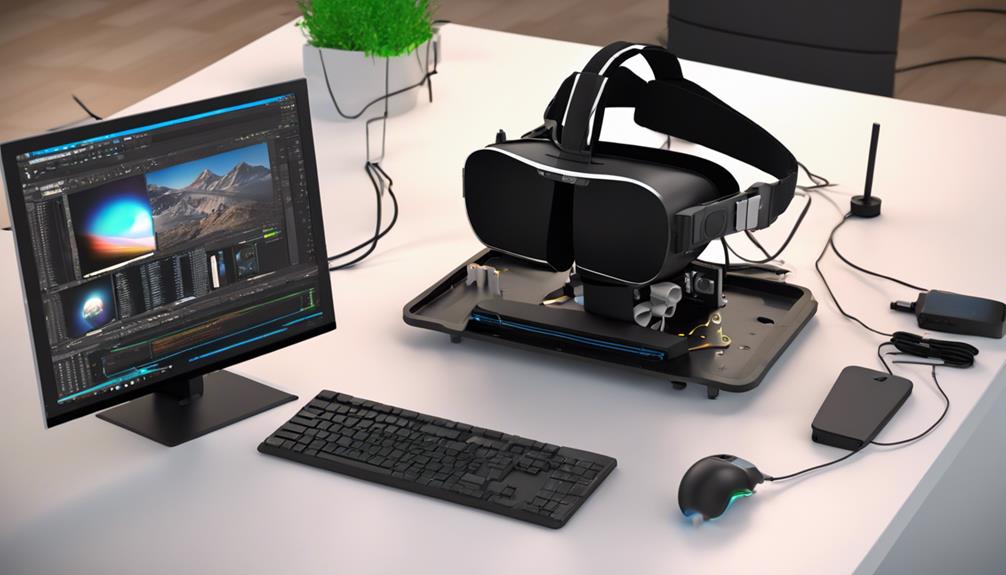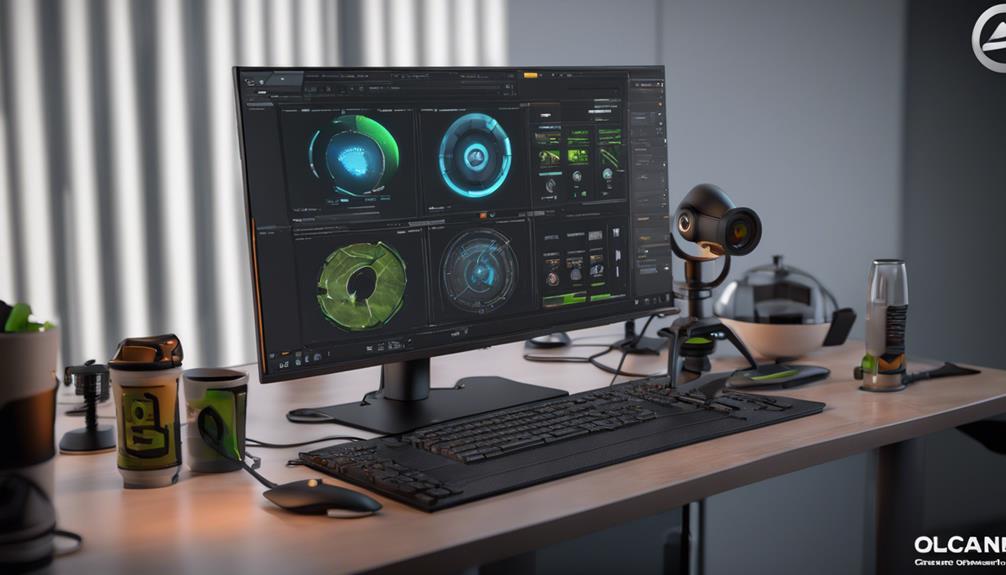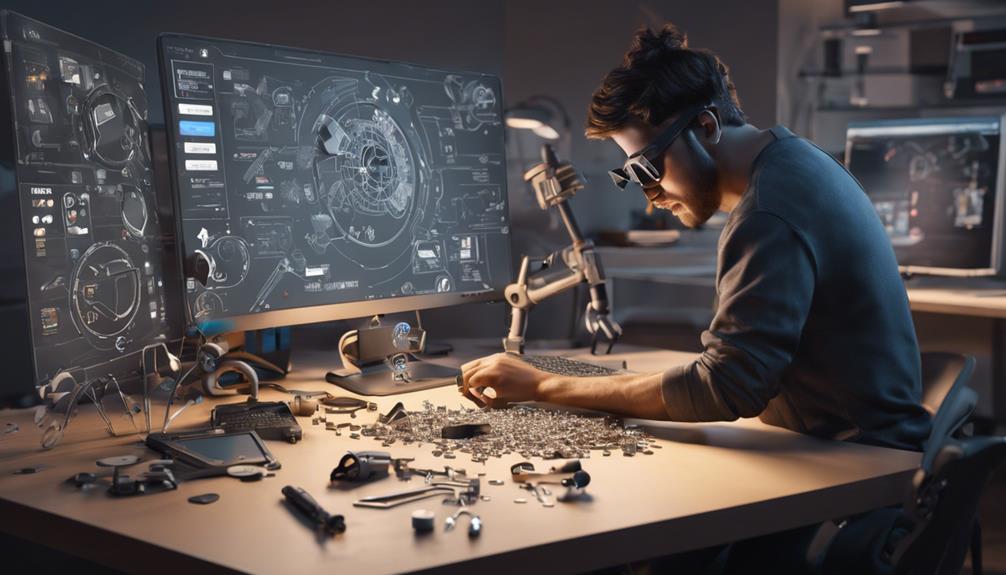Maximize your Oculus Rift experience with the Oculus Tray Tool, optimizing your VR setup for peak performance. Verify that your system meets all requirements and troubleshoot any installation errors promptly. Customize the tool's interface and features to suit your preferences with ease. Enhance visual quality by adjusting supersampling and tweaking ASW settings strategically. Adjust controller tracking sensitivity and monitor real-time performance metrics for an optimized gaming experience. Address common issues like sensor positioning and software conflicts to enjoy seamless VR gameplay. Explore the tool's full capabilities to uncover advanced settings and more.
Key Takeaways
- Customize Oculus Rift settings for better performance and experience.
- Manage supersampling, ASW, power settings, and more.
- Monitor and optimize real-time performance metrics.
- Troubleshoot common VR issues for smoother gameplay.
- Enhance visual quality and hardware efficiency.
Compatibility and Installation

To guarantee smooth operation, confirm that your system meets the minimum requirements before proceeding with the installation of Oculus Tray Tool. Ensuring compatibility with the Oculus Rift is essential for an excellent VR gaming experience. Before installation, check that your system specifications align with the tool's requirements to avoid any potential issues.
Troubleshooting installation errors is vital to ensure a successful setup. If you encounter any difficulties during the installation process, double-check that your system meets the necessary prerequisites. Common installation errors can often be resolved by updating drivers, ensuring adequate disk space, or running the installation as an administrator.
Once installed, the Oculus Tray Tool offers performance monitoring capabilities to enhance your VR gaming experience. By monitoring key performance metrics such as frame rates, GPU usage, and temperature, you can adjust settings in real-time to optimize performance. This monitoring feature allows you to fine-tune your VR experience for smoother gameplay and better overall performance.
Customization Features Overview
Explore the array of customization features within the Oculus Tray Tool to tailor your VR gaming setup to your preferences and optimize performance. One of the key aspects of the tool is its user interface customization, allowing you to personalize the layout and appearance to suit your needs. The feature toggling capability enables you to easily enable or disable specific functions based on your requirements, providing a seamless user experience.
Below is a breakdown of some of the customization features available in the Oculus Tray Tool:
| Feature | Description |
|---|---|
| User Interface Customization | Personalize the layout and appearance of the tool for a tailored experience. |
| Feature Toggling | Easily enable or disable specific functions as needed for a customized setup. |
| Performance Impact Analysis | Get insights into how each customization affects performance to optimize your settings effectively. |
| User Feedback Integration | Utilize user feedback to continuously improve the tool's features and performance. |
The performance impact analysis feature allows you to analyze how each customization setting affects the performance of your VR experience. By integrating user feedback, the Oculus Tray Tool can continuously evolve to meet the needs of its users, ensuring a more refined and optimized gaming experience tailored to your preferences.
Performance Optimization Tips

An effective approach to enhancing your VR gaming setup involves implementing performance optimization tips within the Oculus Tray Tool. To guarantee a smooth and immersive experience with your VR headset, optimizing performance is essential.
Here are some key tips to enhance your gaming experience:
- Supersampling: Adjusting the supersampling level can have a substantial impact on the visual quality of your VR games. By increasing this setting, you can enjoy sharper images and more detailed graphics, improving your overall gaming experience. However, be mindful that higher supersampling levels can also strain your hardware, so find the right balance that works for your system.
- ASW Settings: Asynchronous Spacewarp (ASW) can help improve performance by interpolating frames when necessary. Tweaking the ASW settings in the Oculus Tray Tool can help maintain a smooth VR experience, particularly in demanding games.
- Power Management: Optimizing power management settings can prevent your system from throttling performance during intense VR gaming sessions. Adjusting these settings within the Oculus Tray Tool can ensure that your hardware operates at its best, enhancing your overall gaming experience.
Advanced Settings Walkthrough
Exploring through the advanced settings in the Oculus Tray Tool allows for fine-tuning specific configurations to optimize your VR gaming experience. Here, you can adjust various parameters to enhance your gameplay, including controller tracking and audio settings. Let's dive into the advanced settings walkthrough to understand how you can customize your VR setup further:
| Advanced Setting | Description |
|---|---|
| Controller Tracking | Fine-tune the sensitivity and accuracy of your controller tracking. |
| Audio Settings | Adjust the spatial audio, microphone levels, and output device settings. |
| Performance Metrics | Monitor real-time performance metrics such as FPS, GPU & CPU usage. |
| Super Sampling | Enhance visual clarity by adjusting the super sampling resolution. |
| ASW Settings | Configure Asynchronous Spacewarp settings for smoother VR experiences. |
When working with controller tracking settings, you can tweak parameters like sensitivity and accuracy to guarantee precise movements and interactions within the virtual environment. Additionally, adjusting the audio settings allows you to optimize spatial audio cues, microphone input levels, and select the desired output device for an immersive experience. By utilizing these advanced settings in the Oculus Tray Tool, you can tailor your VR setup to suit your preferences and elevate your gaming sessions to new heights.
Troubleshooting Common Issues

To address any potential issues that may arise during the optimization process using the advanced settings in the Oculus Tray Tool, troubleshooting common problems is an essential step.
When troubleshooting tracking issues, start by confirming that your Oculus sensors are positioned correctly and that there are no obstructions blocking their view. Verify that there are no reflective surfaces in the vicinity causing interference. If tracking problems persist, recalibrate your sensors through the Oculus software.
For software conflicts, check for any recent updates or installations that may have triggered the issue. Disable any background applications that could be conflicting with the Oculus Tray Tool. Updating your graphics card drivers and making sure that your operating system is up to date can also help resolve software conflicts.
In cases of audio problems, make sure that your Oculus Rift headset is set as the default audio output device in your system settings. If audio concerns persist, try unplugging and reconnecting the headset or restarting the Oculus software.
When troubleshooting controller connectivity problems, begin by checking the batteries in your controllers. If the issue continues, try repairing the controllers through the Oculus software. Ensure that there are no wireless devices causing interference with the controllers' signals. If problems persist, consider resetting the controllers to their factory settings.
Conclusion
To sum up, the Oculus Tray Tool is a valuable tool for optimizing your VR experience. With its customization features, performance optimization tips, and advanced settings, you can tailor your virtual reality setup to your preferences.
By following the installation instructions and troubleshooting common issues, you can guarantee a smooth and immersive VR experience every time you use your Oculus device.
Make the most of your VR experience with the Oculus Tray Tool.
